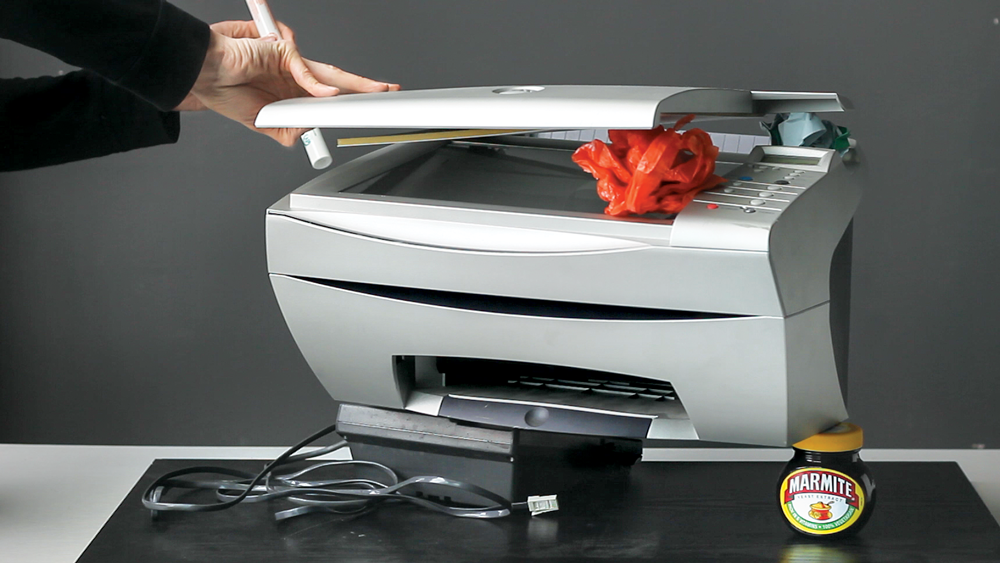Inside a vacant low-rise office in Glasgow, artists Richard Ibghy and Marilou Lemmens are working hard at trying not to work at all. Using odds and ends left behind by the last tenant, an insurance company, the pair is in the midst of what you might call an improvisational intervention on the idea of work itself.
Lemmens angles lengths of wood, board and a chair into a floor-to-ceiling barricade across a hallway; stacks fluorescent-light fixtures held by a letter tray and computer cable on a desk; doggedly places a garbage can on the rotating base of an upturned desk chair; and balances a desktop printer, its lid propped open by a crumpled plastic bag and white-board markers, on a desk phone and a jar of Marmite. At one point, she sits at a table with a cup of tea. At another, she lays out a picnic lunch on the office floor. The office wall clock remains stopped at 1:13.
Lemmens’s painstakingly made constructions eventually collapse, or at least are never complete. Her hallway barricade and desktop constructions topple. She constantly shifts and moves partitions and re-balances chairs. Against a wall, she leans and piles furniture, a standing fan, cardboard and wood, among other office detritus, then takes it all apart and starts over. Watching the action—or inaction—unfold in the duo’s video Real failure needs no excuse (2012), it slowly becomes clear that this experiment in what they call “non-goal oriented action” is not about producing, but resisting, an end result. It’s the process that counts.
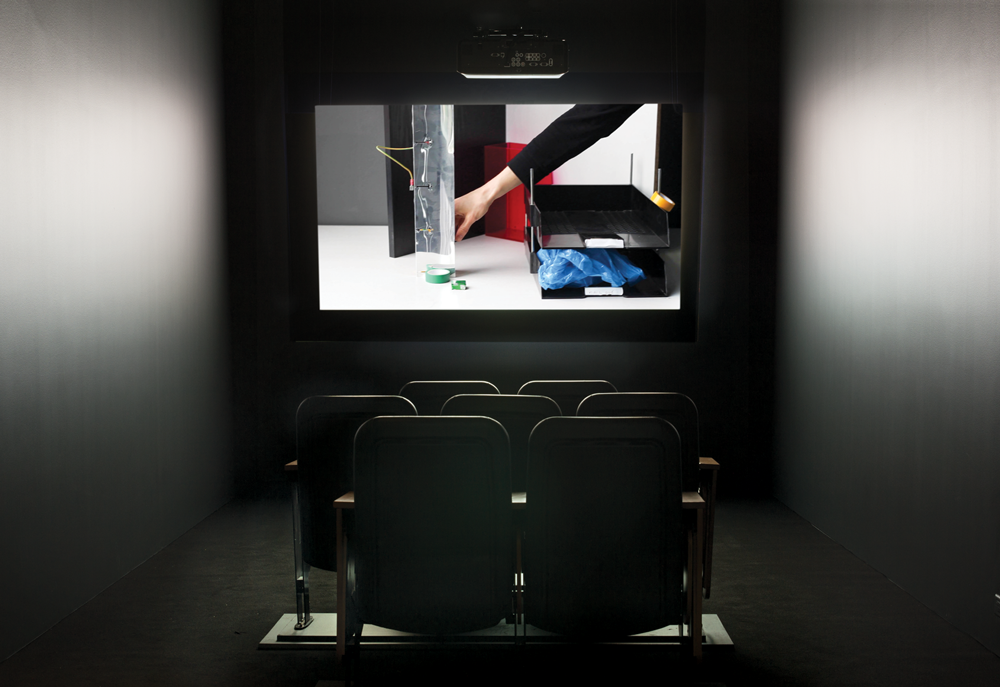 Richard Ibghy and Marilou Lemmens, Real failure needs no excuse (still), 2012. Installation view at Leonard and Bina Ellen Gallery.
Richard Ibghy and Marilou Lemmens, Real failure needs no excuse (still), 2012. Installation view at Leonard and Bina Ellen Gallery.
“Nothing was staged. Nothing was redone,” explains Lemmens when we met this spring in Montreal, where Real failure needs no excuse was on view in the couple’s micro-survey at the Leonard and Bina Ellen Art Gallery, “Putting Life to Work.” “It was going every day,” says Lemmens. “Putting the camera on and just seeing what happens. When it was finished, it was finished. Everything in the space was dedicated to the efficiency of work. It turned into something extremely abstract: if you don’t have a goal when you act, there isn’t an end for an action. It can continue forever.”
“And when you have no objective, the idea of success and failure dissipates,” adds Ibghy. “Nothing can be a failure.”
This strategy of wilful non-production has become an evolving blueprint for Ibghy and Lemmens over the past decade. Informed by meticulous research into modes of production and the history of labour, along with a keen sense for the undervalued role the body plays in measuring success, the duo’s performances, videos, sculptures and installations intuitively resist neoliberal values such as optimized bottom-line results and a consumer culture predicated on overdose.
How and what do we produce, and in what ways do we participate in work? In an era of “cognitive capitalism” and the “knowledge economy,” labour is increasingly indefinable, immaterial and precarious. Efficiencies once determined by a punch clock are now only a smartphone away. Ibghy and Lemmens’s experiments offer a reflective gauge that is as much affect as effect. For them, work is not merely a site, action or theoretical framework, but an ongoing negotiation between body and mind. As “Putting Life to Work” curator Véronique Leblanc puts it, the duo strives “to unlearn what work is.”
This impetus came from a sequence of unexpectedly formative discoveries. After meeting at Concordia University in the late 1990s and spending the better part of the 2000s living and working in Europe and North Africa, as well as Montreal, New Brunswick and Vancouver, where Lemmens did an MFA at the University of British Columbia (Ibghy holds a bachelor’s degree in philosophy and an MBA), the pair landed at the Banff Centre in 2009 for the residency Beyond Former Heaven (or the Institute of Surrealist Ethnography), led by artist Olivia Plender.
“We worked with a group of people on the idea of research in a performative way,” says Ibghy, “using the body very much to explore different or alternative modes of communal living—self-education, forms of antitheatre, physical improvisation.”
“It was a different way of working,” says Lemmens. “There was really an interest for us in the tension between the body and conceptual systems and ideas of time—what doesn’t translate, what doesn’t fit, but also how they can play off one another. We wanted to bring the cognitive elements in our work to completion, to test them in a real environment, in a real situation, with people, to see what happens that you can’t get at if you’re just writing or thinking.”
At the time, Ibghy and Lemmens were making videos, photo works, drawings and large-scale text-based wall installations that re-presented the language, symbols and systematic calculations of economic-labour theory. Steeped in a textbook conceptualist desire to analyze information and plot critique, the work opened doors for the duo, including a string of international residencies and participation at the 10th Sharjah Biennial in 2011.
But, as the duo soon realized, this work carried the baggage of an art-world politics that holds direct action at arm’s length. “We were looking at the internalization of labour,” says Lemmens. “This is the rationality of our time, the rationality that we live and definitely participate in. If we want to try to understand how it can be undone, we needed to involve ourselves personally. You need to give a place for your politics in what you do.”
A 2012 residency in Berlin further reinforced this. During a discussion after the duo’s video projection and performance, The Willful Undertaking of Serious Chances (2012), it was proposed that while they definitely had a structure, their approach was ironically lacking in unpredictability and risk. “It was very controlled,” Lemmens recalls. “In the pre-recorded video, we were actually playing with chance in a much looser way. Some of the comments were, if you’re interested in chance you should let it happen, you should take those risks. After that we started leaving a lot more room for those uncontrolled elements in what we do.”
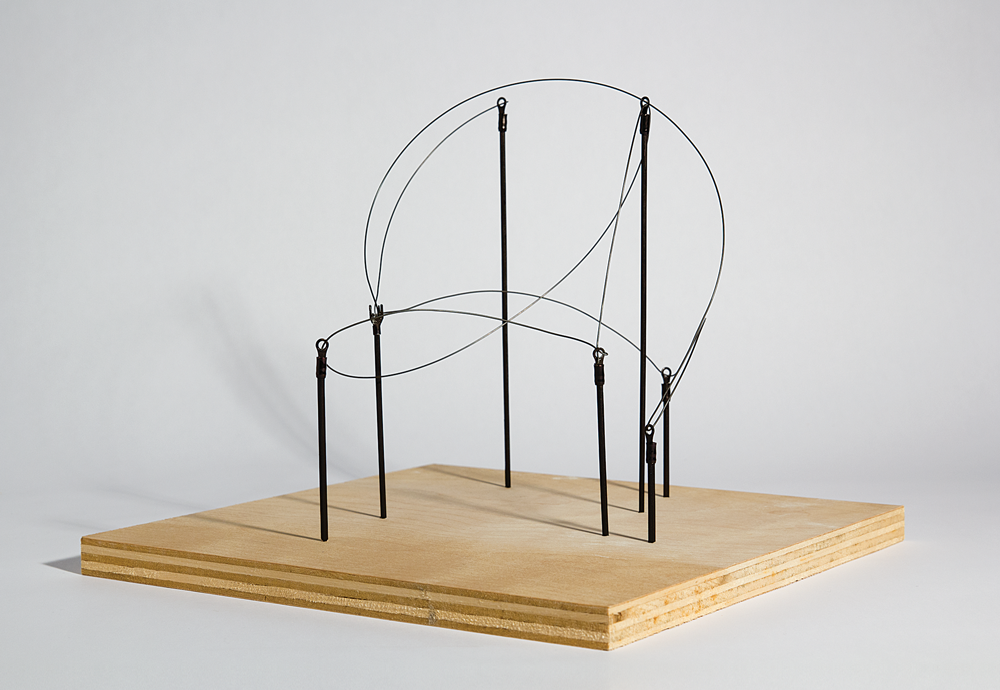 Richard Ibghy and Marilou Lemmens, Motion Efficiency Study (from the series Each Number Equals One Inhalation and One Exhalation), 2016.
Richard Ibghy and Marilou Lemmens, Motion Efficiency Study (from the series Each Number Equals One Inhalation and One Exhalation), 2016.
In the works that followed, including Real failure needs no excuse, the duo’s longstanding interests in modes of production and labour are explored with more looseness and spontaneity. For Visions of a Sleepless World (2014–15), Ibghy and Lemmens developed a speculative scenario based on a 1964 film by avant-garde Belgian-born French writer Henri Michaux. The film was originally commissioned by pharmaceutical giant Sandoz as an in-house research tool on the hallucinogenic effects of hashish and mescaline. In Ibghy and Lemmens’s fictitious update, featuring Swiss performance artist Andrea Saemann, they are also commissioned by a pharmaceutical company to make an educational film, only this time it’s to study the effectiveness of a new wakefulness drug on round-the-clock productivity and consumption, the next step in neurocognitive capitalism.
In the resulting video, Saemann plays out a series of free-association actions. She paces the room, methodically examines papers on a table and sits listlessly staring. With minimal direction from Ibghy and Lemmens, she appears increasingly irrational and troubled. Like Real failure, the video is an unfolding experiment in the motivational psychology of labour, disrupting the rational boundaries between thinking and doing. Indeed it’s unclear if this is a performance at all—so convincing is the depiction of the merging of mind and body.
Is there anything left to be done at all? (2014/16) was designed as self-reflexive response to a production residency at Trinity Square Video in Toronto. Ibghy and Lemmens invited dancer and choreographer Justine A. Chambers, hardcore singer Ryan Tong and artists Kevin Rodgers and Rodrigo Marti to explore, as they put it, “the desires that drive their practices,” but in contrast to the exhibition-as-end-result, to do so without it culminating in anything concrete. Working independently in the gallery over a number of days, each participant was gradually prompted to move beyond the known parameters of their work and the perceived need to perform or to be productive. Essentially, they traded expectation for improvisation.
“At one point [Chambers] was doing something very simple,” says Ibghy. “She was getting up and going back down on the floor, really focusing on each movement. Then she just stopped. When I asked her why, she said in the beginning she was really focused on analyzing every movement, but then she stopped caring. That was very interesting.”
In the installation version at the Leonard and Bina Ellen Art Gallery, video documentation is projected on an array of seven monitors and screens, surrounded by sculptural props from each of the performances. It’s a complex display, with images and sound overlapping and intermingling at every turn: all of the activity is happening simultaneously, without beginning or end. This is an intentional move by Ibghy and Lemmens to confuse set institutional expectations of artistic production and the exhibition. But it’s also how you might imagine the kinetic social space, the “spirit,” as they put it, of the residency project itself: a convergence of unresolved potential.
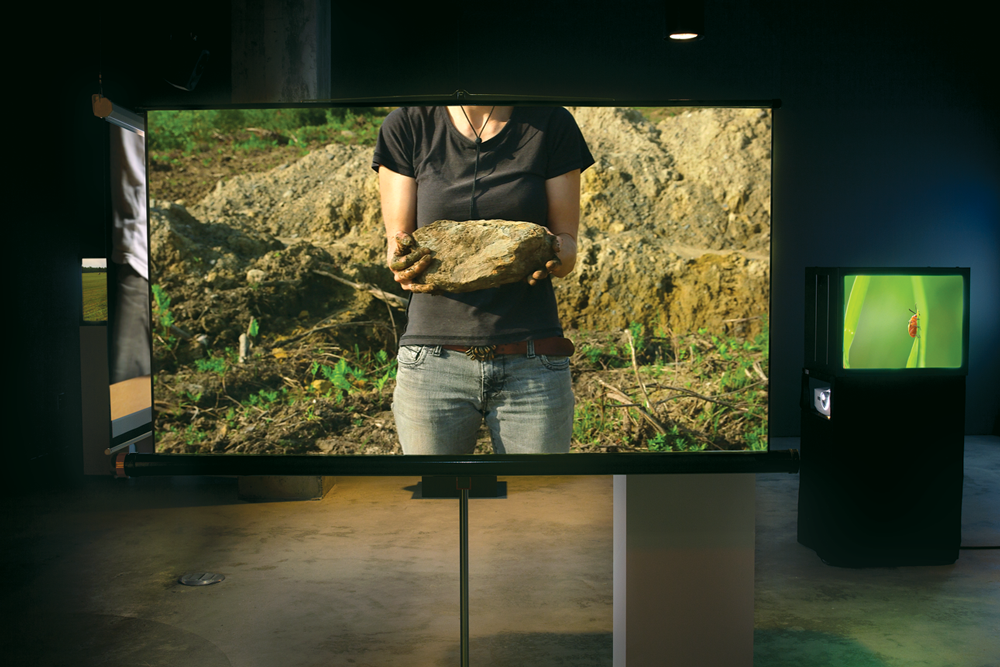 Richard Ibghy and Marilou Lemmens, The Golden USB, 2014–. Installation view at Leonard and Bina Ellen Gallery.
Richard Ibghy and Marilou Lemmens, The Golden USB, 2014–. Installation view at Leonard and Bina Ellen Gallery.
Each of these projects is a kind of research laboratory, always angled toward the impact of economic history and the changing nature of labour on the psychology of contemporary life. The Golden USB (2014–) is a sprawling multimedia installation inspired by the Voyager Golden Record, the first-contact time capsule of human civilization that was launched into outer space in 1977. Ibghy and Lemmens’s proposition is that the Golden Record was a product of its time, a grand collaborative humanist gesture that mirrored the space-race fascination with reaching out to the stars. What would that look like if we were to do the same thing now, when utopian ideals have been replaced by resource exploitation and consumption?
The duo started work on a trade catalogue of everything: resources, products, ideas, history, people—an ever-expanding list of items available for acquisition in a new era of interstellar capitalism. For the installation, part of the 2014 Biennale de Montréal, Ibghy and Lemmens filled the gallery with a spread of video monitors and projection screens each displaying samples from the trade catalogue’s inventory. In one projection, Lemmens is in the countryside randomly choosing and presenting a tree branch, a chunk of dirt and an armful of long grass, among other unlikely commodities. In another video, everyday objects—a hand drill, rice noodles, a bottle of Windex, a baseball glove—are set out one after the other. Tucked away in reliquary fashion in a back room is the golden USB itself, the access key to capitalist society run amok.
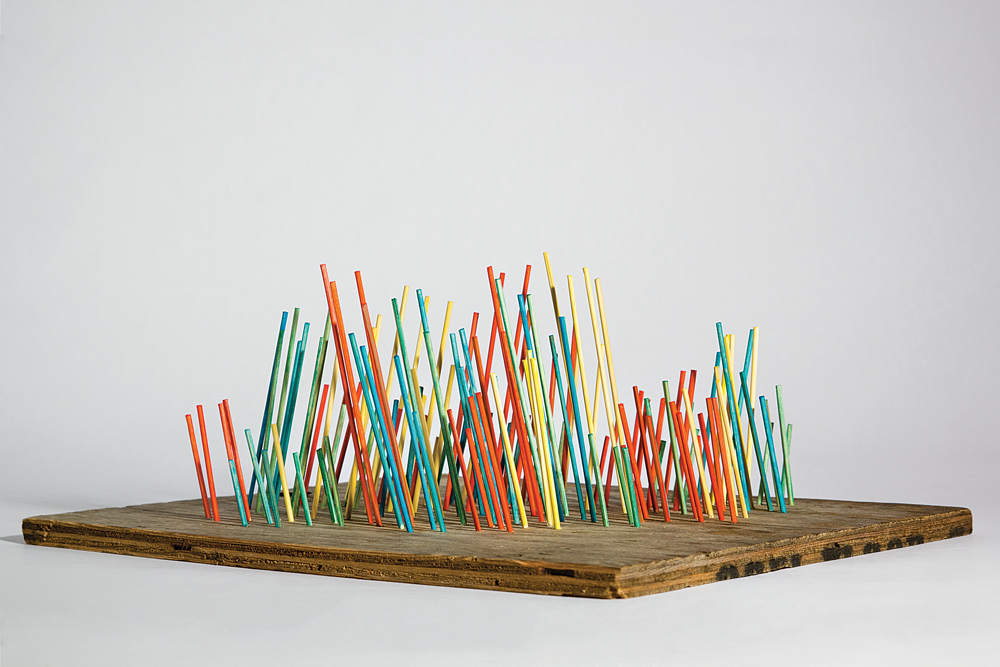 Richard Ibghy and Marilou Lemmens, Circulation Route, Projected Teams and Total Workplace at Google Berlin, 2016.
Richard Ibghy and Marilou Lemmens, Circulation Route, Projected Teams and Total Workplace at Google Berlin, 2016.
Ibghy and Lemmens’s most recent work is Each Number Equals One Inhalation and One Exhalation (2016), an ongoing series (they worked with similar ideas at the 2014 Biennale de Montréal and 2015 Istanbul Biennial) of small sculptural diagrams derived from statistical analyses of productivity and workforce efficiencies, from the mid-19th century to the present. Graphs and charts on rarefied subjects such as Standardized Regression Coefficients Predicting Team Performance, Motions of a Clerical Worker and Output Among Men Polishing Metal on a Ten-Hour Shift with No Rest Breaks Except for Lunch are expanded into delicate three-dimensional forms built from wood, string, wire and plastic. From the hands-on process of Ibghy and Lemmens constructing these rough sculptural models to the way a viewer negotiates the worktable-like standards that filled the main space of the Leonard and Bina Ellen Art Gallery, it’s a project that reintroduces a critical human element into what is otherwise elusive scientific data. Each is a study in resistance to the authority of productivity.
How do you value time or action? What are the intangible nuances of life and labour that defy quantification? When do measures of success become abstracted to the point of absurdity? Ibghy and Lemmens don’t have answers. Rather, by giving these statistics and ideas bodily form, they return them to reality. “Our lives may be one long enterprise and you try to maximize the output,” says Ibghy. “But real life is messier. It cannot be simplified for maximum efficiency.” Sometimes it’s not how hard you work, but how hard you don’t work, that really makes a difference.
Bryne McLaughlin is senior editor at Canadian Art. This article originally appeared in the Summer 2016 issue of our magazine. To get every issue delivered to your door before it hits newsstands, visit canadianart.ca/subscribe.

